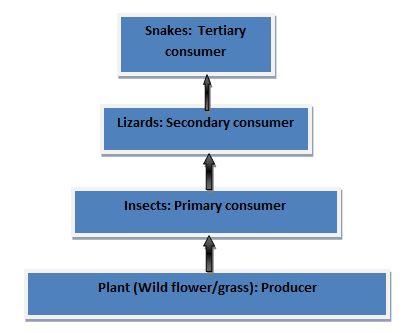
The figure above shows an example of a food chain found in the desert ecosystem. The food chain is divided into nutritional levels whereby the lowest level is occupied by produces, the second level by primary consumers, the third level by secondary consumers, and the fourth level by tertiary consumers (Feller, 2012).
The desert ecosystem is often considered to be one of the harshest to living organisms. This paper seeks to describe the desert ecosystem regarding the major categories of organisms; their interactions and food chains; potential hazards due to human activity; and the abiotic factors present. The ecosystem is usually considered oppressive to organisms that thrive in it. Plants such as shrubs, cactus, wildflowers, and grasses are the primary producers in the desert ecosystem where they produce energy through photosynthesis (Rohli & Vega, 2008). Many plant organisms in the ecosystem have adapted mechanisms to minimize the effects of sunlight (Feller, 2012).
Annual plants shorten their life cycles by going dormant when conditions become harsh. Waking from dormancy by such plants is typically marked by a sudden carpet of wildflowers often from species such as the time travelers. In Colorado, the US, some perennial plants such as Joshua trees apply a different strategy whereby they flourish in moist periods and lay low during the dry season.
Many desert plants have sharp spines and chemical-filled leaves to avoid being eaten by animals. An animal that feeds on plants in the desert ecosystem is classified as the primary consumer. Primary consumers such as the kangaroo rat look for seeds that are safe to eat, usually rare to find. The energy manufactured by plants flows into primary consumers/herbivores such as Kangaroo rats and jackrabbits, which are preyed on by secondary consumers/carnivores like snakes and bobcats (Rohli & Vega, 2008).
Large trees such as the Joshua tree often play a critical role in the desert ecosystem. The trees provide homes for birds, lizards, and insects. Some birds feed on seeds or nectar, while others feed on insects that inhabit the trees. Fallen trees provide food for detritivores such as termites which are in turn eaten by lizards like the Yucca night lizard. The lizards are eaten by carnivores such as owls and snakes to continue the energy flow cycle (Feller, 2012). Decomposers in the desert ecosystem are mainly bacteria and fungi. The following food chains might also be found in the desert ecosystem:
Pants (forbs) → Mule Deer → Mountain lion
Plant (Shrub seeds) → Quail→ Coyote
Plant (Seeds) → Rats→ Snakes→ Hawk
Several ecosystems are threatened by different human activities including land clearance for infrastructure or industries, bush fires, and air pollution (Feller, 2012). Land clearance destroys plants which play an important role as primary producers and also provide habitats for a variety of birds and insects. The clearance might result into starvation and extinction of the various organisms that play a role in the desert ecosystem energy flow. Bush burning contributes to the emission greenhouse gases into the atmosphere and also destroys plants and animals either directly or indirectly.
Apart for the biotic factors, there are abiotic factors that also play a very important role in the maintenance of an ecosystem. The abiotic factors found in the desert ecosystem include air, sand, sunlight, temperature, and water (Feller, 2012).
References
Feller, W. (2012). Desert ecosystem. Web.
Rohli, R., & Vega, A. (2008). Climatology. New York: Bartlett Learning.